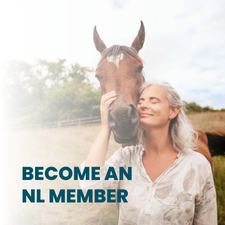By Bettina Shultz-Jobe, Tim Jobe, Kate Naylor, and Laura McFarland
The following is an excerpt from the Natural Lifemanship Manual. Our manual is intended to serve as a resource to support students’ learning as they move through our Fundamentals and Intensive trainings. (The suggested citation is at the end of this article)
When people are uncertain about something in their lives, they seek guidance. Frequently, guidance comes in the form of instructions or advice – someone telling us what to do. But each of us is a unique individual, with subtle differences and nuanced needs, and so are the animals and clients with whom we work.
At The Natural Lifemanship Institute, we strive to recognize the individuality of each being and offer guidance on the subject of Equine Assisted Services with this in mind. This means, though, that prescriptive advice on “what to do” is extremely limiting – it does not allow for the individuality of you, the doer, and others, the recipients of your doing.
This is why NL is principle-based rather than technique focused – rather than offer you things to do, we aim to give you ideas from which to cultivate your own thinking, and for your clients to develop their own thinking.
Principles offer structure without dictating the details.
Our principles are our beliefs. They are what we see as truths in the world, for humans and non-humans alike based on decades of observation, experience, and research science. You and your clients will come to develop your own principles as well – this is an important part of the therapeutic process.
We teach from principles for several reasons,
1) Our principles let you know who we are (our values, ethics, motivations, and goals)
2) Teaching from principles allows you to understand the “why” of our and your choices, rather than only offering you the “what” – enabling you to use your full self, your creativity and unique gifts and skills, in response to the complete individuality of the “other” with whom you are engaged, and
3) Because principles transfer from horse to human to the world at large, and techniques don’t.
For example, imagine a client, facilitator, and equine professional riding in an arena for their session. As the three riders pick up a trot, the client begins to bounce in the saddle while the two members of the facilitation team do not. The client notices this in frustration, and wants help to ride the trot better.
A technique focus would motivate the team to coach the client to, for example, put his heels down, keep his hands still and soft, and sit deeper in the saddle. This advice might improve his riding, but what does it offer him outside of this moment? What does he take home to remember and use with his family, his peers, in his own body, and in his relationships with the world around him?
If we revisit this moment from a principle-based perspective, we look at the “why” underneath the behavior of the client bouncing in the saddle. Brain science and relational principles tell us that when stress increases, it is harder to control ourselves – we get discombobulated and disorganized.
So the issue is not hands or heels, it is stress and the body’s response to stress that are causing the hands and heels to be out of control. What the client needs then, is more development of regulation skills – skills for organizing himself in moments of stress.
The facilitators, coming from this wider perspective, can begin to help the client tune in to his body’s response to the stress of trotting so he can become more aware of what is happening internally. He is encouraged to notice his heart rate, his breathing, his muscle tension and practice ways to calm himself, release tension, breathe more deeply…all things the team supports him in developing.
THIS he can take into the rest of his life, as well as improve his riding.
The client now has practiced attuning and attending to his internal experience during stress – an important life skill. And, because the guiding principle is simply that stress causes disorganization (which feels like chaos) and healing requires organization (calm/regulation) – the therapy team has a wide variety of options on where exactly to go next with this particular client.
The goal is to get reorganized around stress – the paths are many, and are dictated by the therapy team’s scope of practice and unique skill set. A coach will approach this moment differently than a somatic therapist, who would approach things differently than an OT, who would approach things differently than a child psychologist with training in mindfulness – but each professional can be guided by this principle of disorganization and reorganization, of stress and calm.
Note that this is not the only principle at play in this example, but one of many…. another principle may be that regardless of the task, connection is the goal. Guiding the client to connect with himself, and connect more deeply with his horse, would be a practice that serves him both in and out of the saddle.
A principle based approach offers guidance AND allows for individuality and creativity–– an organic unfolding of the therapeutic process.
With this in mind, here is a list of principles we find to be true and that guide our work. Oftentimes, we think of these truths as Laws of the Universe: Rules I didn’t make, so I can’t change them.
This list is by no means exhaustive, and hopefully, allows space for compelling conversation as you continue your learning journey with us!
- A good principle is a good principle regardless of where it is applied
- The relationship is the vehicle for change
- Principles transfer, techniques do not
- If it’s not good for both, eventually it’s not good for either
- True healing cannot happen at the expense of another
- The way you do anything is the way you do everything
- Knowledge cannot be pushed into a brain, it must be pulled in
- Consent is a clear “yes” that is freely given; rather than simply the absence of a “no”
- All beings have the right to choice: choice to resist, ignore, or connect/cooperate with a request with freedom from fear of punishment
- Animal welfare issues are also clinical issues
- Regardless of the task or activity, a connected relationship is always the goal
- Relationships begin with requests
- There is no effective self-regulation without safe co-regulation first
- Pressure is a natural fact of life so how we apply it and respond to it is very important.
- In healthy relationships and secure attachment, the internal, felt sense of connection remains whether the relationship partner is physically present or not
- Connection with self is not necessary before we can connect with others, but it is necessary in order to request connection from others
- Control and connection cannot coexist – this is true as it relates to connection with self and others
- Objects can be metaphors, living beings cannot
- We can learn about healthy relationships through simpler interactions with horses
- Animals are sentient beings
- The relationship with the horse is a real relationship. Therefore, the horse is not a tool, a metaphor, an instrument, a mirror, or a deity.
- If we truly want to have healthy, connected relationships with our horses we must shift our focus from what is good for THE horse to what is good for THIS horse.
- Horses will respond now the way humans will. . . eventually.
- Having healthy boundaries is about focusing on what I want/need instead of focusing on what I don’t want/need. The need to “set” boundaries is a connection issue.
- Communication must be seen within its context – the individuals, environment, and moment in time
- Brain integration ⟺ Secure Attachment
- Regardless of what is going on around me, it is possible to manage what is happening inside of me
- If you cannot appropriately manage yourself, someone else will
- Safety comes from a connected relationship; connection cannot come from arbitrary safety rules
- Rupture and repair are inevitable and necessary when building connection and healthy relationships.
- Relationships don’t require nor can they tolerate perfection. In the face of perfection there is no room for grace or growth. Relationships need both.
- The horse doesn’t know who the “client” is which is why our own personal growth and awareness is so important
- Who we are in session is more important that what we do
- What you DO is technique, who you ARE is principle
Registration for the next Fundamentals of Natural Lifemanship training opens January 12th! We hope to see you there.
Copyright © by Natural Lifemanship, LLC. All rights reserved.
SUGGESTED CITATION:
Jobe, T., Shultz-Jobe, B., McFarland, L. & Naylor, K. (2021). Natural Lifemanship’s Trauma Informed Equine Assisted Services. Liberty Hill: Natural Lifemanship.



Recent Comments